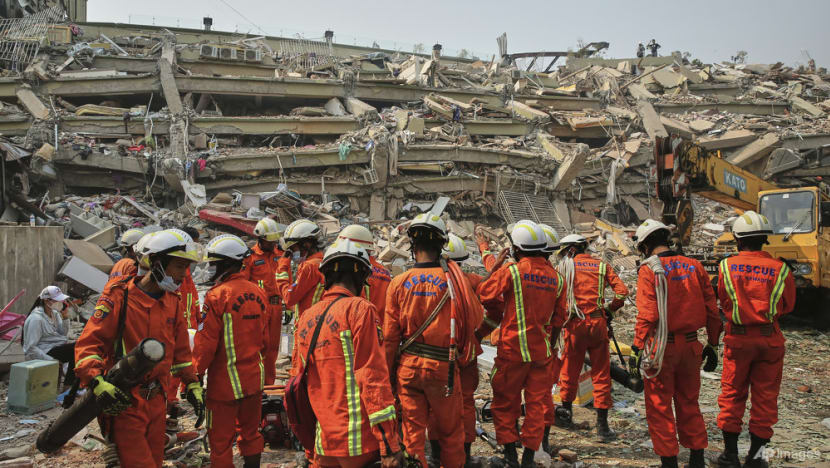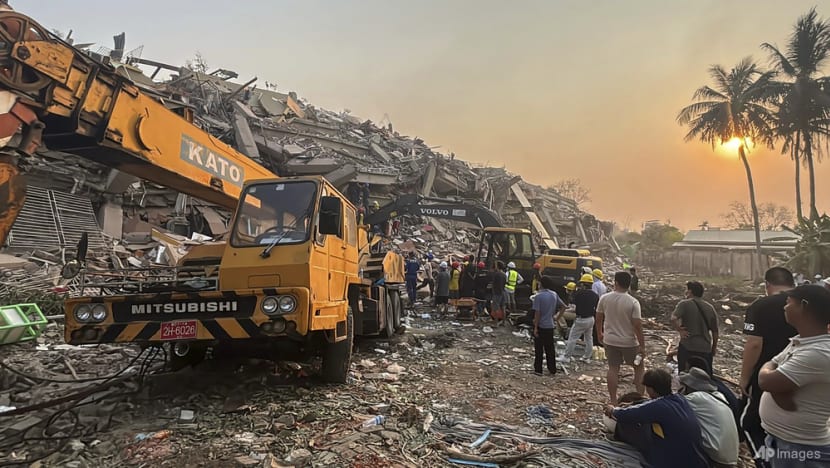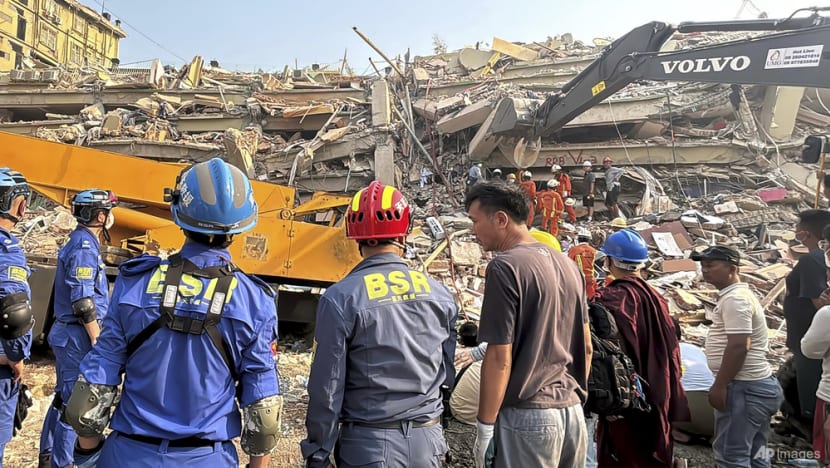‘Not sure of their chances of survival’: Rescue workers in quake-hit Myanmar race against time
The so-called 72-hour “golden window” for finding survivors buried under rubble has closed.

In this photo released by Xinhua News Agency, rescuers prepare to conduct a search and rescue at a collapsed building in the aftermath of an earthquake in Mandalay, Myanmar, Mar 30, 2025. (Photo: Myo Kyaw Soe/Xinhua via AP)

This audio is generated by an AI tool.
MANDALAY: Foreign rescue teams and aid supplies are arriving in Myanmar, as the country copes with the aftermath of a massive earthquake that killed at least 1,700 people.
The 7.7-magnitude quake struck near the central Myanmar city of Mandalay last Friday afternoon (Mar 28), followed minutes later by a 6.7-magnitude aftershock.
Rescue workers are now racing against time, as the so-called 72-hour “golden window” for finding survivors buried under rubble has closed.

“IMPROVISING WITHIN OUR CAPACITIES”
The disaster response in hard-hit Mandalay has been hampered by a lack of proper equipment, said observers.
A Mandalay fireman recounted an operation to rescue a mother and son trapped inside a collapsed building, but efforts so far have not led to a breakthrough.
“This is happening all around the country and we do not have enough manpower and equipment,” he said. “So, we are improvising within our capacities.”
The CNA team on the ground has observed that despite a lack of equipment and training, locals have rushed to help, digging through rubble with their bare hands to search for survivors.
Shortly after the quake, Myanmar’s military chief Min Aung Hlaing made a rare plea for international assistance and a call for blood donations for victims.
Singapore is among the various Association of Southeast Asian Nations (ASEAN) member states that has sent teams to assist in disaster rescue.
The regional bloc’s efforts in relief operations are led by its Coordinating Centre for Humanitarian Assistance.
SLOW ACCESS TO WORST-HIT ZONES
On Saturday, the Singapore Civil Defence Force (SCDF) deployed its Operation Lionheart contingent to Myanmar.
The 80-member team comprises rescuers from the elite Disaster Assistance and Rescue Team (DART), operationally ready National Servicemen, full-time National Servicemen medical doctors, paramedics, search specialists with four canines, hazardous materials specialists, and support officers.
Myanmar’s allies such as China, Russia and Belarus are also among the countries that have sent aid.
In a statement, doctors and civil servants on strike said they are prepared to be deployed to junta-controlled zones, provided the military can guarantee their safety and will not arrest them.
Experts warned that access to the worst-hit areas will be slow as roads and bridges have been destroyed in the quake.
“I think we will only find dead bodies,” said one Mandalay fireman.
“Because it has been so long since they were under the rubble. I'm not sure of their chances of survival, because of the pressure, the vibration and the intensity of the damage.”
This is not the first time Myanmar has been hit with a natural disaster since the 2021 military coup that ousted a democratically elected government and plunged the nation into civil war.
Last year, Typhoon Yagi triggered severe floods and mudslides in Myanmar, killing more than 400 and destroying hundreds of thousands of acres of crops.
“We've seen over and over again the resilience of Myanmar's people,” said Karah Brink, a spokesperson at humanitarian service organisation Partners Relief and Development.
“But this crisis is taking its toll and at this moment, the needs are very dire. There's great concern about the junta's ability to meet these needs and respond with empathy to the people of Myanmar.”

JUNTA CONTINUES STRIKES ON VILLAGES
Even as the junta seeks international help to cope with quake relief, it has continued to conduct airstrikes on civilian targets.
“It is definitely a massive humanitarian risk when the very people who are reeling from this aftermath are also being attacked by the very government that claims that will help them in this moment,” Brink told CNA’s Asia First.
“One of the greatest challenges is the fact that Myanmar is already deep in a dire humanitarian crisis.”
Even before the quake struck, a third of Myanmar’s population was already facing acute food insecurity, according to human rights experts from the United Nations.
Brink said that rural areas, especially in the southern Shan state, are suffering from wide-scale quake damage but are difficult for international aid organisations to access.
“There's destruction of homes, there have been extensive injuries, and community members are asking for urgently needed supplies such as food, drinking water, (and) access to tarps for shelter,” she noted.
Brink hopes the scale of the disaster response can increase, calling for access to be given to allow relief organisations to work alongside local communities.
“Communities that are already struggling to survive day to day are now going to face a mammoth effort of needing to rebuild,” she said.
“It's very real that the junta historically has impeded efforts for rebuilding and that the people of Myanmar will have a very difficult road ahead.”

















